engine TOYOTA GR YARIS 2022 Repair Manual
[x] Cancel search | Manufacturer: TOYOTA, Model Year: 2022, Model line: GR YARIS, Model: TOYOTA GR YARIS 2022Pages: 470, PDF Size: 113.17 MB
Page 153 of 470
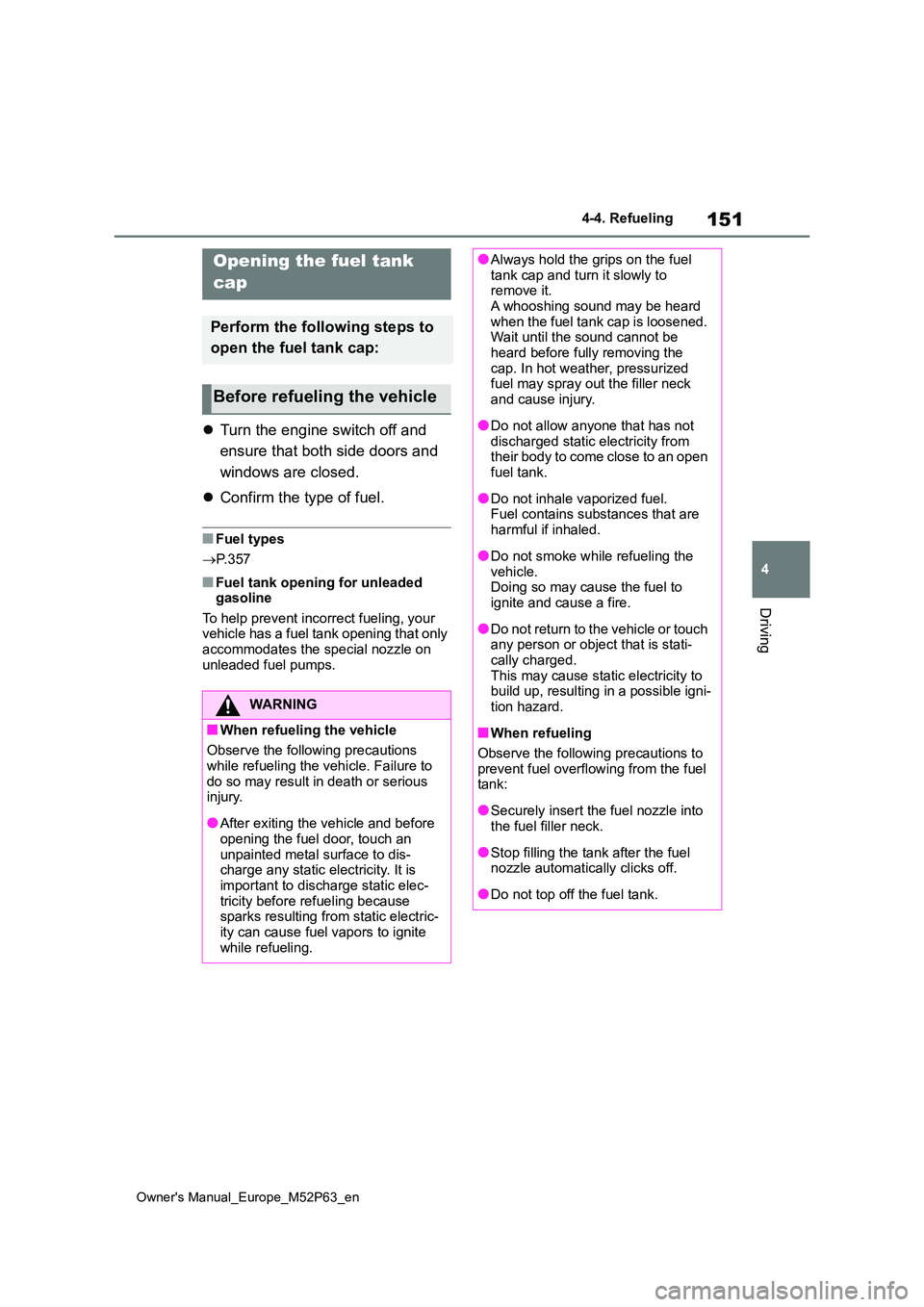
151
4
Owner's Manual_Europe_M52P63_en
4-4. Refueling
Driving
4-4.Refuelin g
Turn the engine switch off and
ensure that both side doors and
windows are closed.
Confirm the type of fuel.
■Fuel types
P. 3 5 7
■Fuel tank opening for unleaded gasoline
To help prevent incorrect fueling, your vehicle has a fuel tank opening that only accommodates the special nozzle on
unleaded fuel pumps.
Opening the fuel tank
cap
Perform the following steps to
open the fuel tank cap:
Before refueling the vehicle
WARNING
■When refueling the vehicle
Observe the following precautions
while refueling the vehicle. Failure to do so may result in death or serious injury.
●After exiting the vehicle and before opening the fuel door, touch an
unpainted metal surface to dis- charge any static electricity. It is important to discharge static elec-
tricity before refueling because sparks resulting from static electric-ity can cause fuel vapors to ignite
while refueling.
●Always hold the grips on the fuel tank cap and turn it slowly to remove it.
A whooshing sound may be heard when the fuel tank cap is loosened. Wait until the sound cannot be
heard before fully removing the cap. In hot weather, pressurized fuel may spray out the filler neck
and cause injury.
●Do not allow anyone that has not
discharged static electricity from their body to come close to an open fuel tank.
●Do not inhale vaporized fuel.Fuel contains substances that are
harmful if inhaled.
●Do not smoke while refueling the
vehicle. Doing so may cause the fuel to ignite and cause a fire.
●Do not return to the vehicle or touch any person or object that is stati-
cally charged. This may cause static electricity to build up, resulting in a possible igni-
tion hazard.
■When refueling
Observe the following precautions to prevent fuel overflowing from the fuel tank:
●Securely insert the fuel nozzle into the fuel filler neck.
●Stop filling the tank after the fuel nozzle automatically clicks off.
●Do not top off the fuel tank.
Page 164 of 470
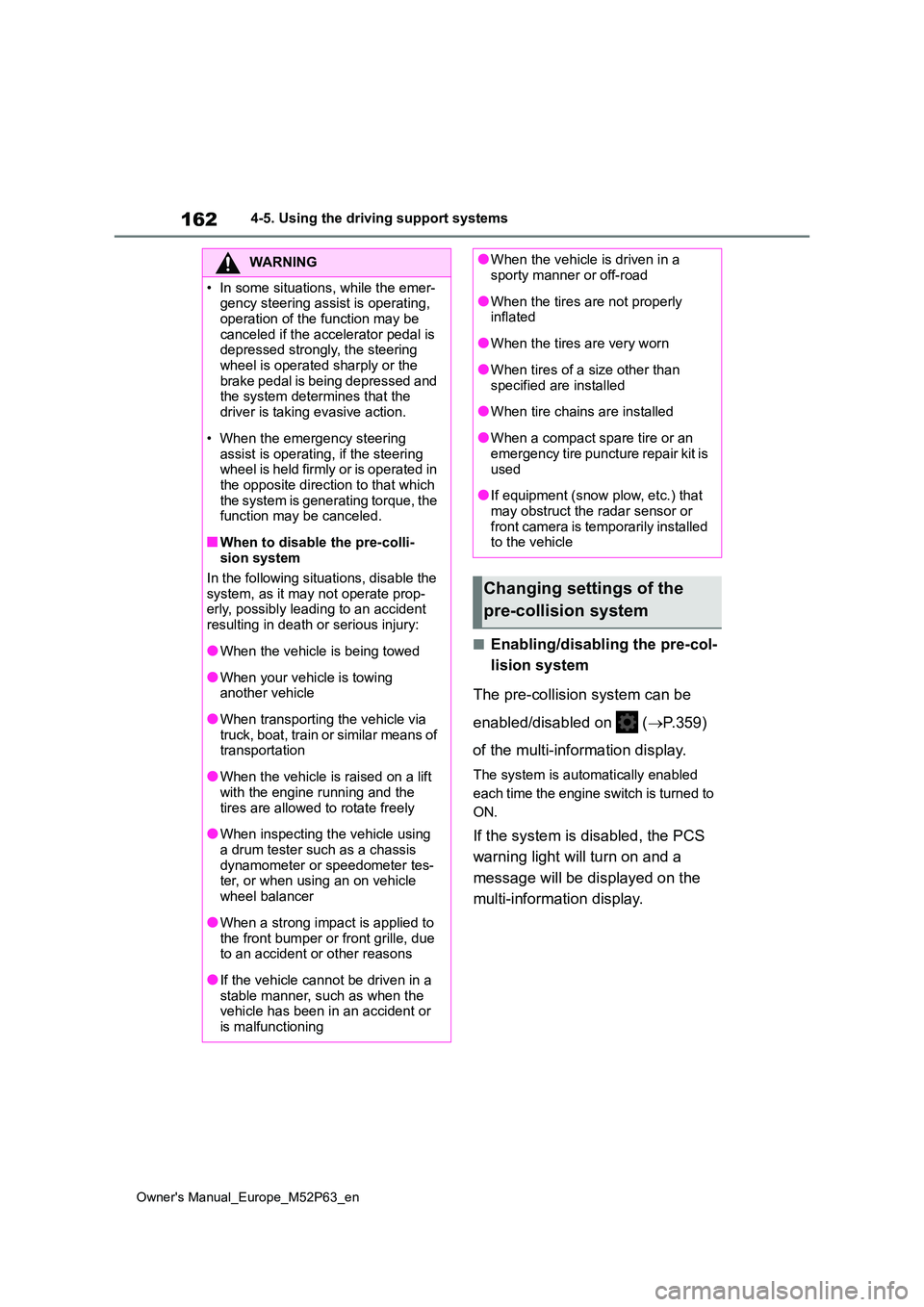
162
Owner's Manual_Europe_M52P63_en
4-5. Using the driving support systems
■Enabling/disabling the pre-col-
lision system
The pre-collision system can be
enabled/disabled on ( P.359)
of the multi-information display.
The system is automatically enabled
each time the engine switch is turned to
ON.
If the system is disabled, the PCS
warning light will turn on and a
message will be displayed on the
multi-information display.
WARNING
�
Page 165 of 470

163
4
Owner's Manual_Europe_M52P63_en
4-5. Using the driving support systems
Driving
“Pre-Collision System OFF”
■Changing the pre-collision
warning timing
The pre-collision warning timing
can be changed on ( P.359) of
the multi-information display.
The warning timing setting is retained
when the engine switch is turned off.
However, if the pre-collision system is
disabled and re-enabled, the operation
timing will return to the default setting
(middle).
For region A: If the pre-collision
warning timing is changed, emer-
gency steering assist timing will
also be changed accordingly.
If late is selected, emergency steer-
ing assist would not operate in case
of an emergency.
1 Early
2 Middle
This is the default setting.
3Late
■Operational conditions for each pre-collision function
The pre-collision system is enabled and the system determines t hat the possibility of a frontal collision with a detected object is high.The system may not operate in the following situations:
• If a battery terminal has been disconnected and reconnected an d then the vehicle has not been driven for a certain amount of time
• If the shift lever is in R
• When the VSC OFF indicator is illuminated (only the pre-collis ion warning function will be operational)
The operation speeds and operation cancellation for each functi on is listed below.
Page 170 of 470
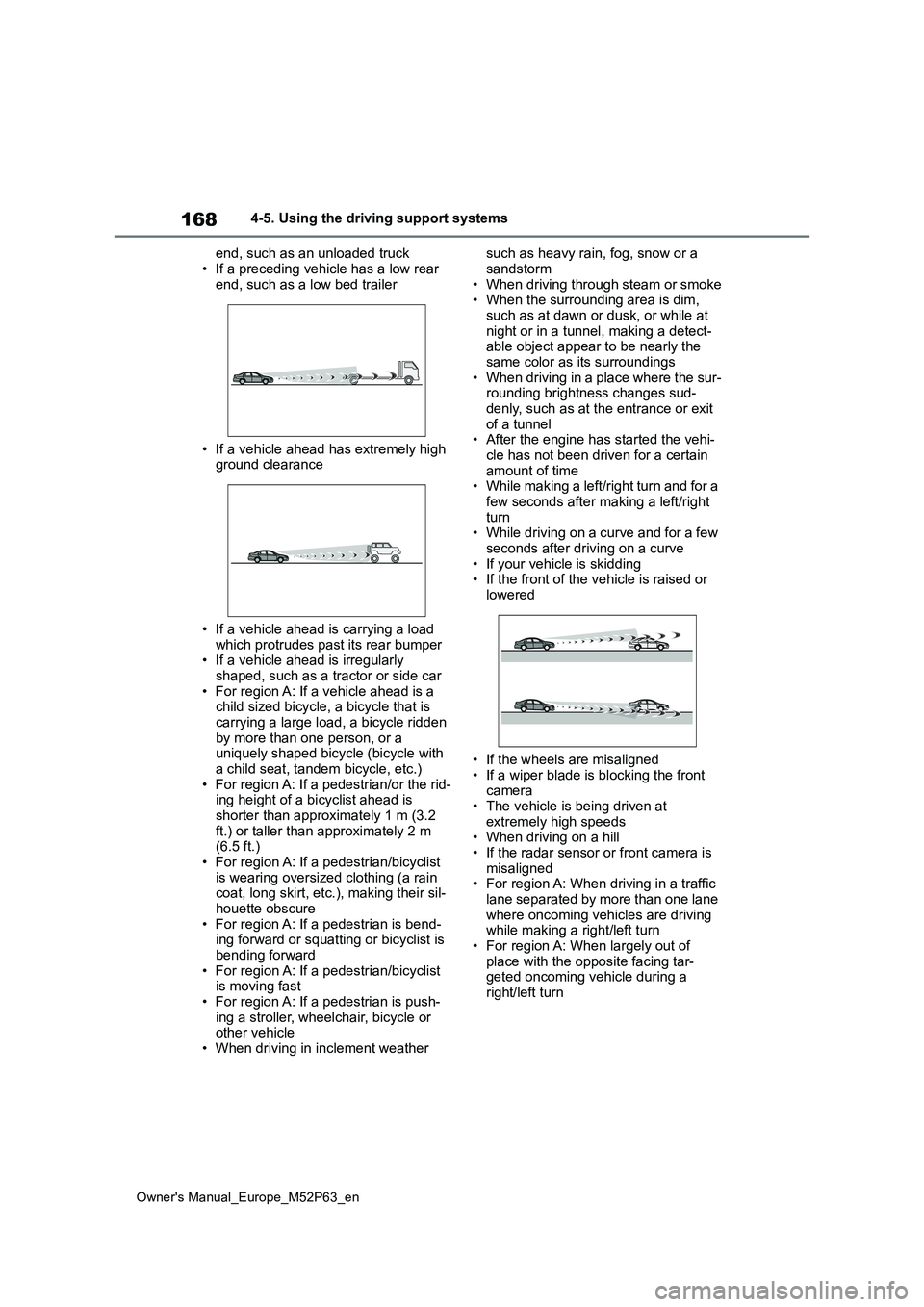
168
Owner's Manual_Europe_M52P63_en
4-5. Using the driving support systems
end, such as an unloaded truck
• If a preceding vehicle has a low rear end, such as a low bed trailer
• If a vehicle ahead has extremely high ground clearance
• If a vehicle ahead is carrying a load which protrudes past its rear bumper• If a vehicle ahead is irregularly
shaped, such as a tractor or side car • For region A: If a vehicle ahead is a child sized bicycle, a bicycle that is
carrying a large load, a bicycle ridden by more than one person, or a uniquely shaped bicycle (bicycle with
a child seat, tandem bicycle, etc.) • For region A: If a pedestrian/or the rid-ing height of a bicyclist ahead is
shorter than approximately 1 m (3.2 ft.) or taller than approximately 2 m (6.5 ft.)
• For region A: If a pedestrian/bicyclist is wearing oversized clothing (a rain coat, long skirt, etc.), making their sil-
houette obscure • For region A: If a pedestrian is bend-ing forward or squatting or bicyclist is
bending forward • For region A: If a pedestrian/bicyclist is moving fast
• For region A: If a pedestrian is push- ing a stroller, wheelchair, bicycle or other vehicle
• When driving in inclement weather
such as heavy rain, fog, snow or a
sandstorm • When driving through steam or smoke• When the surrounding area is dim,
such as at dawn or dusk, or while at night or in a tunnel, making a detect-able object appear to be nearly the
same color as its surroundings • When driving in a place where the sur-rounding brightness changes sud-
denly, such as at the entrance or exit of a tunnel• After the engine has started the vehi-
cle has not been driven for a certain amount of time• While making a left/right turn and for a
few seconds after making a left/right turn• While driving on a curve and for a few
seconds after driving on a curve • If your vehicle is skidding• If the front of the vehicle is raised or
lowered
• If the wheels are misaligned
• If a wiper blade is blocking the front camera• The vehicle is being driven at
extremely high speeds • When driving on a hill• If the radar sensor or front camera is
misaligned • For region A: When driving in a traffic lane separated by more than one lane
where oncoming vehicles are driving while making a right/left turn• For region A: When largely out of
place with the opposite facing tar- geted oncoming vehicle during a right/left turn
Page 177 of 470

175
4
Owner's Manual_Europe_M52P63_en
4-5. Using the driving support systems
Driving
■Turning the lane centering
function ON/OFF
Press the LTA switch.
The lane centering function will change
between ON/OFF each time the switch
is pressed.
The current setting will be displayed on
the multi-information display.
Lane centering function ON
“LTA Steering Assist Active Lane
Centering Active”
Lane centering function OFF
“LTA Steering Assist Active”
■Tu r n i n g t h e LTA s y s t e m O F F
Press and hold the LTA switch
The LTA indicator light turns off when
the LTA is turned OFF.
Press the switch again to turn the sys-
tem on.
The LTA is turned ON each time the
engine switch is turned to ON.
However, the lane centering function
keeps either the ON/OFF state prior to
the engine switch being turned OFF.
LTA indicator
The illumination condition of the indica-
tor informs the driver of the system
operation status.
Illuminated in white: LTA system is
operating.
Illuminated in green: Steering wheel
assistance of the steering assist func-
tion or lane centering function is operat-
ing.
Flashing in orange: Lane departure
alert function is operating.
LTA system setting
Indications on multi-infor-
mation display
Page 189 of 470
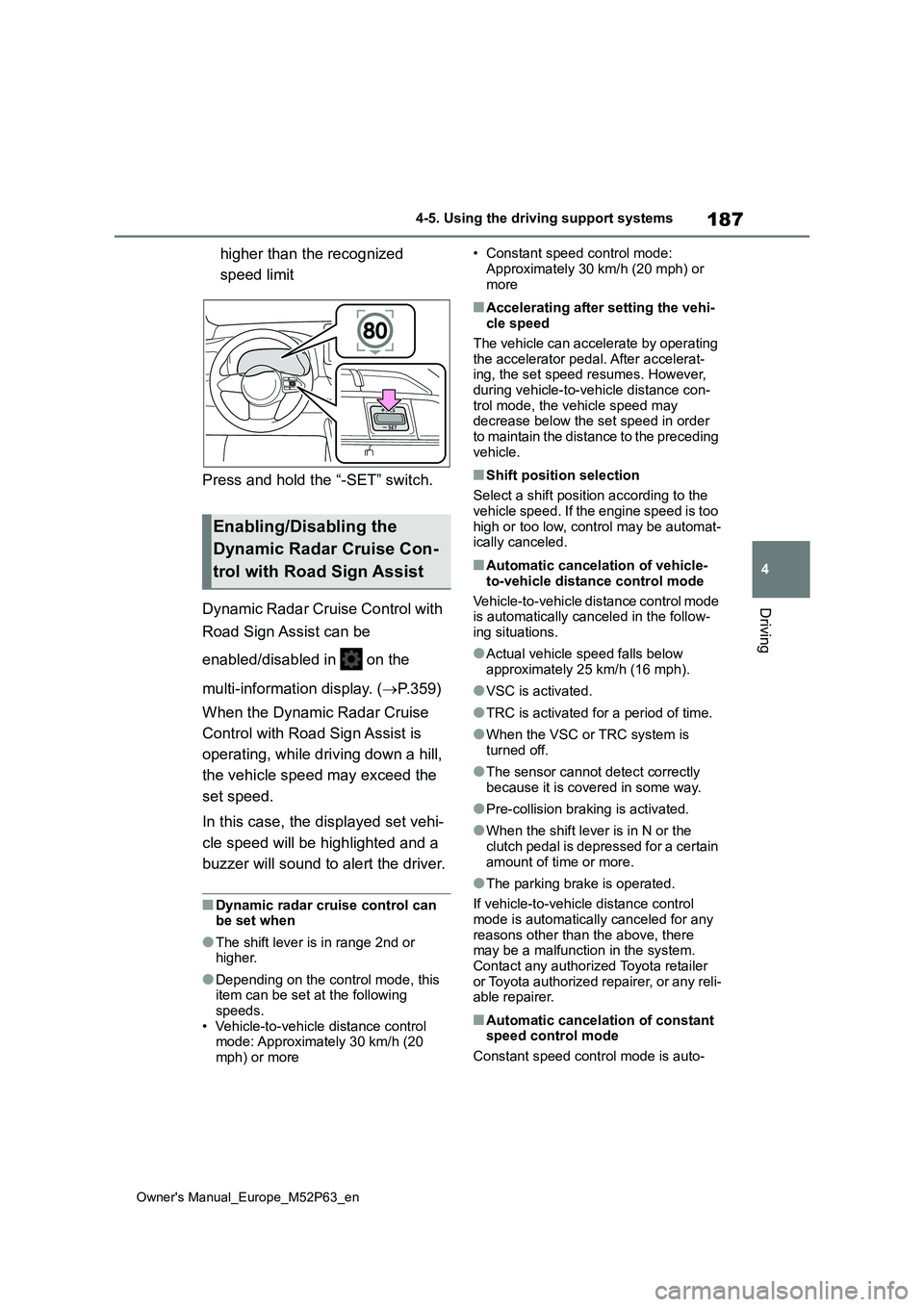
187
4
Owner's Manual_Europe_M52P63_en
4-5. Using the driving support systems
Driving
higher than the recognized
speed limit
Press and hold the “-SET” switch.
Dynamic Radar Cruise Control with
Road Sign Assist can be
enabled/disabled in on the
multi-information display. ( P.359)
When the Dynamic Radar Cruise
Control with Road Sign Assist is
operating, while driving down a hill,
the vehicle speed may exceed the
set speed.
In this case, the displayed set vehi-
cle speed will be highlighted and a
buzzer will sound to alert the driver.
■Dynamic radar cruise control can be set when
●The shift lever is in range 2nd or higher.
●Depending on the control mode, this item can be set at the following
speeds. • Vehicle-to-vehicle distance control mode: Approximately 30 km/h (20
mph) or more
• Constant speed control mode:
Approximately 30 km/h (20 mph) or more
■Accelerating after setting the vehi-cle speed
The vehicle can accelerate by operating the accelerator pedal. After accelerat-ing, the set speed resumes. However,
during vehicle-to-vehicle distance con- trol mode, the vehicle speed may decrease below the set speed in order
to maintain the distance to the preceding vehicle.
■Shift position selection
Select a shift position according to the
vehicle speed. If the engine speed is too high or too low, control may be automat-ically canceled.
■Automatic cancelation of vehicle-
to-vehicle distance control mode
Vehicle-to-vehicle distance control mode is automatically canceled in the follow-
ing situations.
●Actual vehicle speed falls below
approximately 25 km/h (16 mph).
●VSC is activated.
●TRC is activated for a period of time.
●When the VSC or TRC system is turned off.
●The sensor cannot detect correctly because it is covered in some way.
●Pre-collision braking is activated.
●When the shift lever is in N or the
clutch pedal is depressed for a certain amount of time or more.
●The parking brake is operated.
If vehicle-to-vehicle distance control mode is automatically canceled for any
reasons other than the above, there may be a malfunction in the system. Contact any authorized Toyota retailer
or Toyota authorized repairer, or any reli- able repairer.
■Automatic cancelation of constant speed control mode
Constant speed control mode is auto-
Enabling/Disabling the
Dynamic Radar Cruise Con-
trol with Road Sign Assist
Page 195 of 470
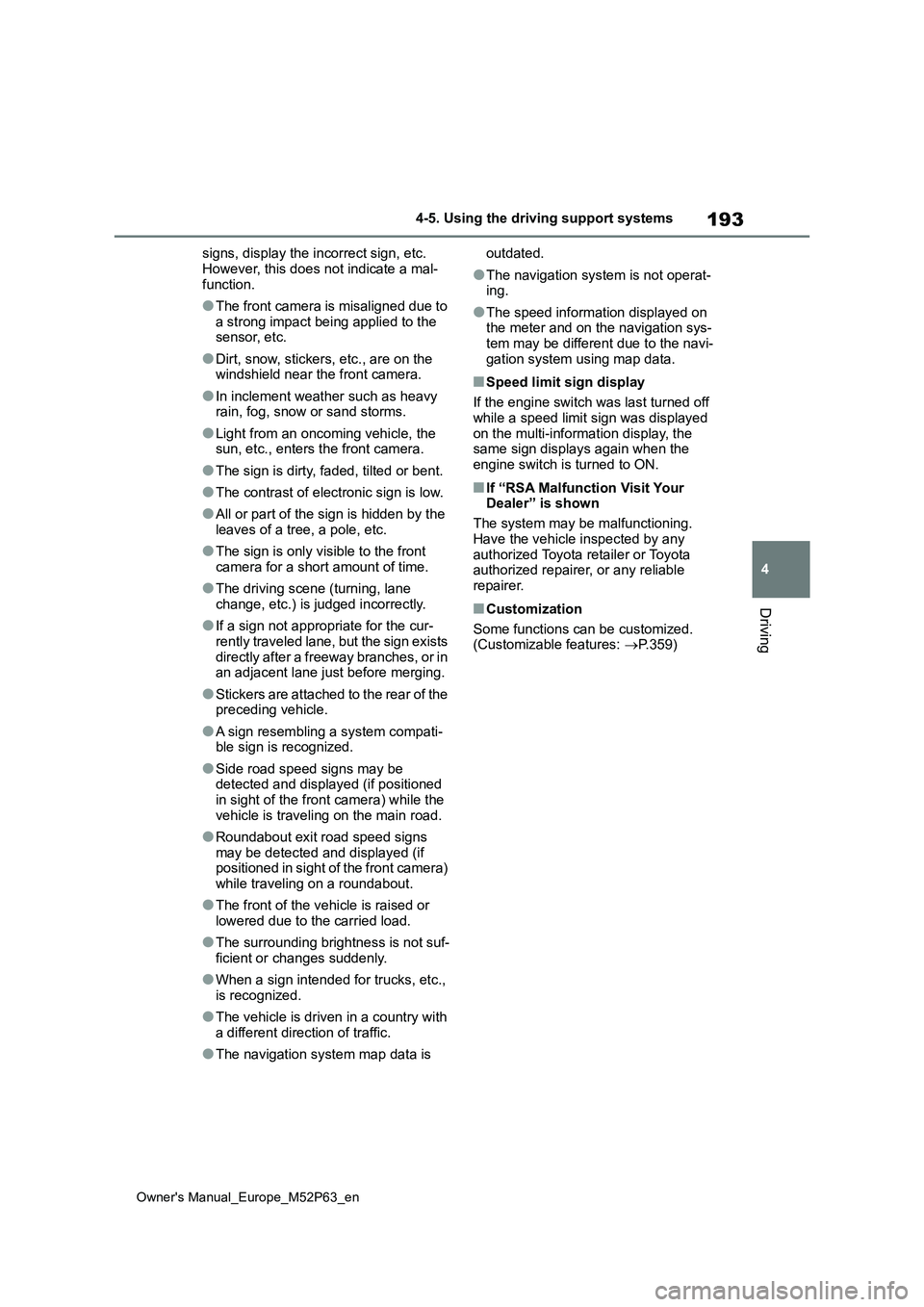
193
4
Owner's Manual_Europe_M52P63_en
4-5. Using the driving support systems
Driving
signs, display the incorrect sign, etc.
However, this does not indicate a mal- function.
●The front camera is misaligned due to a strong impact being applied to the sensor, etc.
●Dirt, snow, stickers, etc., are on the windshield near the front camera.
●In inclement weather such as heavy rain, fog, snow or sand storms.
●Light from an oncoming vehicle, the sun, etc., enters the front camera.
●The sign is dirty, faded, tilted or bent.
●The contrast of electronic sign is low.
●All or part of the sign is hidden by the
leaves of a tree, a pole, etc.
●The sign is only visible to the front
camera for a short amount of time.
●The driving scene (turning, lane
change, etc.) is judged incorrectly.
●If a sign not appropriate for the cur-
rently traveled lane, but the sign exists directly after a freeway branches, or in an adjacent lane just before merging.
●S t ic ke r s a r e a t t ac he d t o t h e r e ar o f t he preceding vehicle.
●A sign resembling a system compati-ble sign is recognized.
●Side road speed signs may be detected and displayed (if positioned
in sight of the front camera) while the vehicle is traveling on the main road.
●Roundabout exit road speed signs may be detected and displayed (if positioned in sight of the front camera)
while traveling on a roundabout.
●The front of the vehicle is raised or
lowered due to the carried load.
●The surrounding brightness is not suf-
ficient or changes suddenly.
●When a sign intended for trucks, etc.,
is recognized.
●The vehicle is driven in a country with
a different direction of traffic.
●The navigation system map data is
outdated.
●The navigation system is not operat- ing.
●The speed information displayed on the meter and on the navigation sys-
tem may be different due to the navi- gation system using map data.
■Speed limit sign display
If the engine switch was last turned off
while a speed limit sign was displayed on the multi-information display, the same sign displays again when the
engine switch is turned to ON.
■If “RSA Malfunction Visit Your Dealer” is shown
The system may be malfunctioning.
Have the vehicle inspected by any authorized Toyota retailer or Toyota authorized repairer, or any reliable
repairer.
■Customization
Some functions can be customized. (Customizable features: P.359)
Page 196 of 470
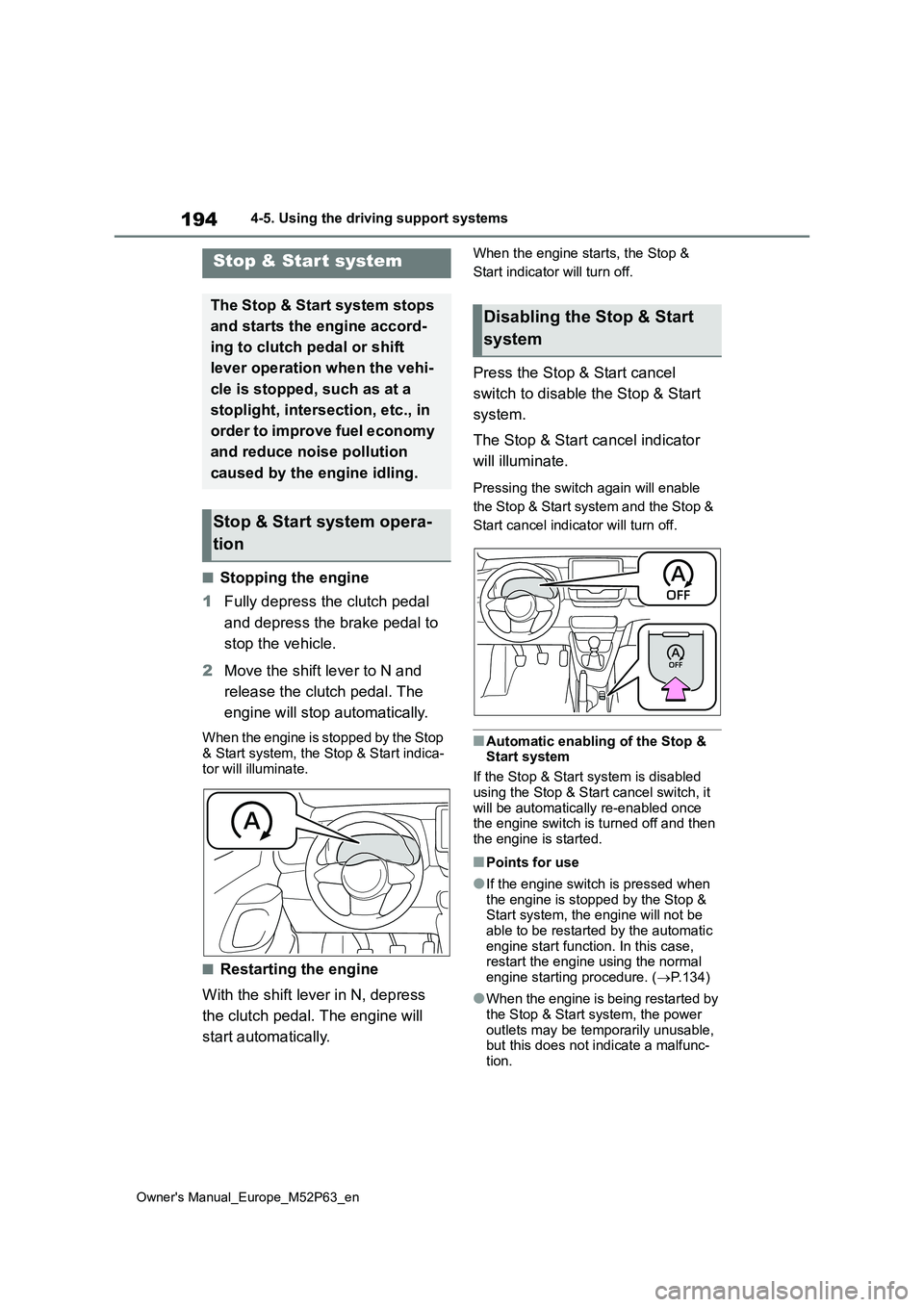
194
Owner's Manual_Europe_M52P63_en
4-5. Using the driving support systems
■Stopping the engine
1 Fully depress the clutch pedal
and depress the brake pedal to
stop the vehicle.
2 Move the shift lever to N and
release the clutch pedal. The
engine will stop automatically.
When the engine is stopped by the Stop
& Start system, the Stop & Start indica- tor will illuminate.
■Restarting the engine
With the shift lever in N, depress
the clutch pedal. The engine will
start automatically.
When the engine starts, the Stop &
Start indicator will turn off.
Press the Stop & Start cancel
switch to disable the Stop & Start
system.
The Stop & Start cancel indicator
will illuminate.
Pressing the switch again will enable
the Stop & Start system and the Stop &
Start cancel indicator will turn off.
■Automatic enabling of the Stop & Start system
If the Stop & Start system is disabled
using the Stop & Start cancel switch, it will be automatically re-enabled once the engine switch is turned off and then
the engine is started.
■Points for use
●If the engine switch is pressed when
the engine is stopped by the Stop & Start system, the engine will not be
able to be restarted by the automatic engine start function. In this case, restart the engine using the normal
engine starting procedure. ( P.134)
●When the engine is being restarted by
the Stop & Start system, the power outlets may be temporarily unusable, but this does not indicate a malfunc-
tion.
Stop & Start system
The Stop & Start system stops
and starts the engine accord-
ing to clutch pedal or shift
lever operation when the vehi-
cle is stopped, such as at a
stoplight, inters ection, etc., in
order to improve fuel economy
and reduce noise pollution
caused by the engine idling.
Stop & Start system opera-
tion
Disabling the Stop & Start
system
Page 197 of 470
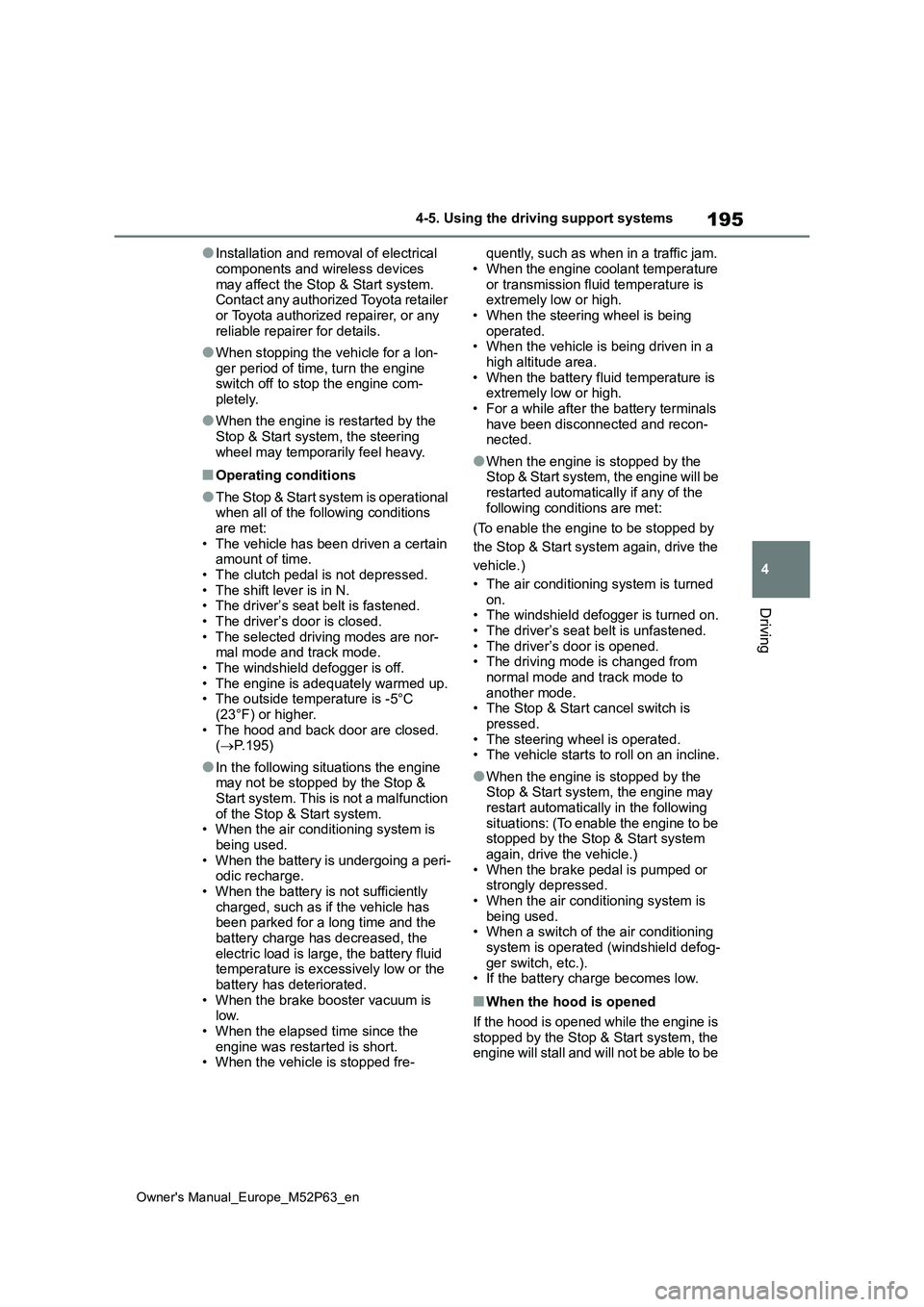
195
4
Owner's Manual_Europe_M52P63_en
4-5. Using the driving support systems
Driving
●Installation and removal of electrical
components and wireless devices may affect the Stop & Start system. Contact any authorized Toyota retailer
or Toyota authorized repairer, or any reliable repairer for details.
●When stopping the vehicle for a lon-ger period of time, turn the engine switch off to stop the engine com-
pletely.
●When the engine is restarted by the
Stop & Start system, the steering wheel may temporarily feel heavy.
■Operating conditions
●The Stop & Start system is operational when all of the following conditions are met:
• The vehicle has been driven a certain amount of time.• The clutch pedal is not depressed.
• The shift lever is in N. • The driver’s seat belt is fastened.• The driver’s door is closed.
• The selected driving modes are nor- mal mode and track mode.• The windshield defogger is off.
• The engine is adequately warmed up. • The outside temperature is -5°C (23°F) or higher.
• The hood and back door are closed. ( P.195)
●In the following situations the engine may not be stopped by the Stop & Start system. This is not a malfunction
of the Stop & Start system. • When the air conditioning system is being used.
• When the battery is undergoing a peri- odic recharge.• When the battery is not sufficiently
charged, such as if the vehicle has been parked for a long time and the battery charge has decreased, the
electric load is large, the battery fluid temperature is excessively low or the battery has deteriorated.
• When the brake booster vacuum is low.• When the elapsed time since the
engine was restarted is short. • When the vehicle is stopped fre-
quently, such as when in a traffic jam.
• When the engine coolant temperature or transmission fluid temperature is extremely low or high.
• When the steering wheel is being operated.• When the vehicle is being driven in a
high altitude area. • When the battery fluid temperature is extremely low or high.
• For a while after the battery terminals have been disconnected and recon-nected.
●When the engine is stopped by the S t o p & S t a r t s y s t e m , t h e e n g i n e w i l l b e
restarted automatically if any of the following conditions are met:
(To enable the engine to be stopped by
the Stop & Start system again, drive the
vehicle.)
• The air conditioning system is turned
on. • The windshield defogger is turned on.• The driver’s seat belt is unfastened.
• The driver’s door is opened. • The driving mode is changed from normal mode and track mode to
another mode. • The Stop & Start cancel switch is pressed.
• The steering wheel is operated. • The vehicle starts to roll on an incline.
●When the engine is stopped by the Stop & Start system, the engine may restart automatically in the following
situations: (To enable the engine to be stopped by the Stop & Start system again, drive the vehicle.)
• When the brake pedal is pumped or strongly depressed.• When the air conditioning system is
being used. • When a switch of the air conditioning system is operated (windshield defog-
ger switch, etc.). • If the battery charge becomes low.
■When the hood is opened
If the hood is opened while the engine is
stopped by the Stop & Start system, the engine will stall and will not be able to be
Page 198 of 470
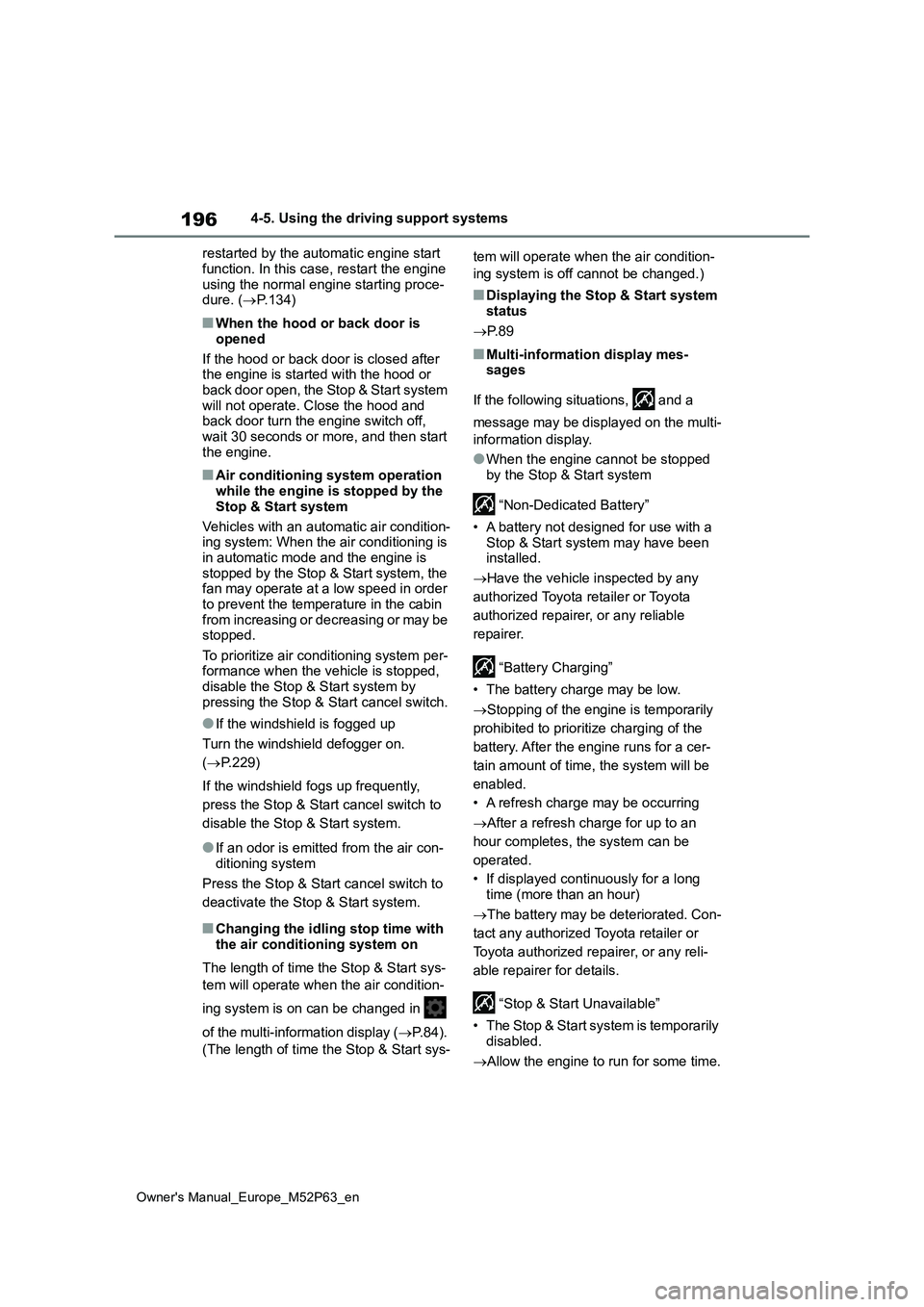
196
Owner's Manual_Europe_M52P63_en
4-5. Using the driving support systems
restarted by the automatic engine start
function. In this case, restart the engine using the normal engine starting proce-dure. ( P.134)
■When the hood or back door is
opened
If the hood or back door is closed after the engine is started with the hood or
back door open, the Stop & Start system will not operate. Close the hood and back door turn the engine switch off,
wait 30 seconds or more, and then start the engine.
■Air conditioning system operation while the engine is stopped by the
Stop & Start system
Vehicles with an automatic air condition- ing system: When the air conditioning is
in automatic mode and the engine is stopped by the Stop & Start system, the fan may operate at a low speed in order
to prevent the temperature in the cabin from increasing or decreasing or may be stopped.
To prioritize air conditioning system per- formance when the vehicle is stopped, disable the Stop & Start system by
pressing the Stop & Start cancel switch.
●If the windshield is fogged up
Turn the windshield defogger on.
( P.229)
If the windshield fogs up frequently,
press the Stop & Start cancel switch to
disable the Stop & Start system.
●If an odor is emitted from the air con- ditioning system
Press the Stop & Start cancel switch to
deactivate the Stop & Start system.
■Changing the idling stop time with
the air conditioning system on
The length of time the Stop & Start sys-
tem will operate when the air condition-
ing system is on can be changed in
of the multi-information display ( P.84).
(The length of time the Stop & Start sys-
tem will operate when the air condition-
ing system is off cannot be changed.)
■Displaying the Stop & Start system status
P. 8 9
■Multi-information display mes- sages
If the following situations, and a
message may be displayed on the multi-
information display.
●When the engine cannot be stopped
by the Stop & Start system
“Non-Dedicated Battery”
• A battery not designed for use with a
Stop & Start system may have been installed.
Have the vehicle inspected by any
authorized Toyota retailer or Toyota
authorized repairer, or any reliable
repairer.
“Battery Charging”
• The battery charge may be low.
Stopping of the engine is temporarily
prohibited to prioritize charging of the
battery. After the engine runs for a cer-
tain amount of time, the system will be
enabled.
• A refresh charge may be occurring
After a refresh charge for up to an
hour completes, the system can be
operated.
• If displayed continuously for a long time (more than an hour)
The battery may be deteriorated. Con-
tact any authorized Toyota retailer or
Toyota authorized repairer, or any reli-
able repairer for details.
“Stop & Start Unavailable”
• The Stop & Start system is temporarily disabled.
Allow the engine to run for some time.